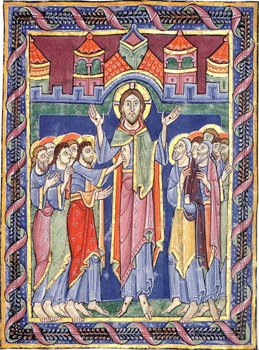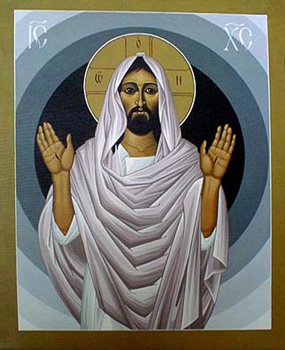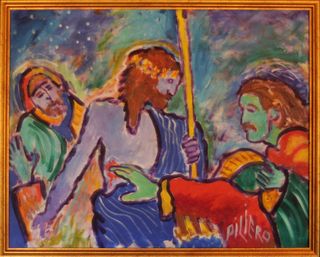For Sunday April 15, 2018
Lectionary Readings (Revised Common Lectionary, Year B)
Psalm 4
1 John 3:1-7
Luke 24: 36b-48
In this week’s Gospel reading, Jesus finds himself struggling to convince his disciples that he’s not dead. It’s a bizarre predicament to be in, if you think about it. Imagine walking into a room and having your closest friends scream, faint, or shrink away in terror at the sight of you. Imagine having to explain to them over and over again that you’re not a ghost, a zombie, a demon, or a delusion. That you are, in fact, real — alive, approachable, and trustworthy. How would you make your case? What would you say or do to calm their fears?
In the post-resurrection story St. Luke tells, Jesus does two things to dispel the skepticism of his disciples, and each speaks powerfully to the kind of witness he calls us to bear to the world.
First, Jesus shows his friends his hands and feet. It’s easy to gloss over this detail, but again, consider its strangeness. We don’t usually identify each other by our hands and feet. If I’m trying to find a friend or family member in a crowd, I scan faces. I look for the smile, the hair, or the eyes I recognize. I might mark the person’s height, build, or bearing. But hands and feet? How many of our friends even know what our feet look like?
What’s remarkable about Jesus is that he chooses the most revealing aspect of himself to share first. His hands and feet bear unmistakable signs of his crucifixion, his defeat, and his vulnerability. They’re not mended and manicured; I imagine he winces when his disciples poke the jagged nails and mangled musculature. His are fresh wounds, still raw and gaping.
 |
In her 1994 book, The Disabled God: Toward a Liberatory Theology of Disability, theologian and professor Nancy Eiesland warns us not to take lightly the fact that Jesus came back to life with his body visibly broken: “The foundation of Christian theology is the resurrection of Jesus Christ. Yet seldom is the resurrected Christ recognized as a deity whose hands, feet, and side bear the marks of profound physical impairment.” “In presenting his impaired body to his startled friends,” she continues, “the resurrected Jesus is revealed as the disabled God.” His injuries remain an essential part of his resurrected identity, neither a divine punishment nor an opportunity for further healing.
What would it be like for us to follow in the footsteps of a disabled God? What would it be like to lead with our scars, instead of enslaving ourselves to society’s expectations of piety and prettiness? Jesus proved that he was alive and approachable by risking real engagement. Real presence. As in: "Here is how you can recognize me. By my hands and my feet. See? I have scars. I have baggage. I have history. I am alive to pain, just as you are. I am not immune; I am real.”
A few years ago, my husband and I found ourselves in the wrenching position of having to hospitalize our then eleven-year-old daughter, who was in danger of losing her life. I was gutted on the day we checked her into the residential facility and walked away; even now I remember that morning as one of the worst of my life. The next day, still reeling from grief and defeat, I wandered into a Christian bookstore, hoping, I suppose, to surround myself with the symbols of a faith I could no longer muster. After a few minutes, a soft-spoken saleswoman came up to me and asked if I needed help. All I could do was cry. She patted my back very kindly. Then she walked over to a jewelry case, rummaged around for a minute, and came back with a crucifix on a slender silver chain. A tiny Jesus hung on his cross, his face drawn in pain. “Wear this,” she said, pressing the necklace into my hands. “Only a suffering God can help.”
The line belongs to Dietrich Bonhoeffer. Supposedly a prison guard found a piece of paper with the line scribbled on it, and smuggled it out of Bonhoeffer's cell shortly before his death. Only a suffering God can help.
 |
The paradox of resurrection is that Jesus's scarred body comforted his disciples. His wounded hands and feet pulled them out of disbelief and into radical, life-altering faith. We dare not treat this fact lightly, because it testifies to a great mystery. As theologian James Alison puts it, Jesus didn’t simply erase death, he carried death’s "shell" on his living body, rendering his scars a trophy — a sign of life’s ultimate and lasting victory. “What type of life is it,” Alison asks in awe, “that is capable not of canceling death out, which would be to stay on the same level as it, but to include it, making a trophy of it, allowing it to be something that can be shown to others in order to allay their fears?”
If even at the apex of his resurrection victory, Jesus’ witness was a witness of scars, then maybe we should take heed. Maybe when the world looks at us to see if we are real, to see if the Jesus we love and the faith we profess is truly approachable and trustworthy, they need to see our scars more than our piety. Our vulnerability, not our triumphalism. Wounds aren't pretty, and no, they don't tell the whole story of the Christian journey. But the stories they do tell are holy. Jesus didn't hide the bloody and the broken. Neither should we.
The second thing Jesus does in this week’s Gospel reading is as unlikely as the first. He expresses hunger. “Have you got anything to eat?” he asks his bewildered disciples, and when they hand him a piece of broiled fish, he eats it in their presence. Such a simple act, but something shifts as a result of it. Something becomes possible that was impossible before. As Jesus eats, the disciples lose enough of their fear to draw close and actually listen to what he’s saying, and their receptivity allows Jesus to “open their minds to understand.” By the end of the encounter, they are no longer frightened men — they are “witnesses of these things,” emboldened for life and ministry. Simply by expressing hunger, inviting hospitality, and accepting nourishment, Jesus turns table fellowship into communion.
 |
Likewise, I believe something powerful happens when we give and receive hospitality as an intentional spiritual practice. Growing up in a South Asian-Asian community in which hospitality was both compulsory and central, I learned early on the magic of a shared table, a generous spread, an open hand. It didn’t matter if a meal was elaborate or simple — all that mattered was the willingness of hosts and guests to gather around a common table and share whatever was available. In my parents’ house, this sometimes meant a scrumptious multi-course dinner around an elaborately decorated table. At other times, it meant microwaving leftover chicken curry and passing it around with Wonder bread. It didn’t matter. Eating together broke down barriers, eased awkwardness, and fostered intimacy. Somehow, as long as the table was kept open and inviting, nourishment happened.
Perhaps the necessary way in which to read Jesus’s question (“Have you got anything to eat?”) is as a gentle reminder. In their fear and confusion, the disciples forgot the most basic rules of hospitality. Instead of offering Jesus food, water, shelter, or comfort, they pulled away, keeping themselves aloof because they were suspicious and afraid. So Jesus reminded them of their most fundamental calling — once again, by leading with vulnerability: “Friends, I’m hungry. Would you please feed me?”
In her beautiful memoir, Take This Bread, Sara Miles, a self-described “blue-state, secular intellectual; a lesbian; a left-wing journalist with a habit of skepticism,” relates what happened to her when she wandered into a church one day and “ate Jesus.” She was hungering and thirsting for righteousness, she writes, and she “found it at the eternal and material core of Christianity: body, blood, bread, wine, poured out freely, shared by all. I discovered a religion rooted in the most ordinary yet subversive practice: a dinner table where everyone is welcome, where the despised and outcasts are honored.”
 |
For Miles, this conversion at the communion table eventually led her to start a ministry centered on real food, real hunger, and real bodies. She opened food pantries all over San Francisco, feeding hundreds of people each week — people from all walks of life. As she describes it, her work lead her to meet “thieves, child abusers, millionaires, day laborers, politicians, schizophrenics, gangsters, and bishops,” widening what she considered her community in ways both scary and exhilarating.
Do we need Jesus's gentle reminder as urgently as his disciples did? What if pushing past fear — fear of the stranger, fear of our inadequate culinary skills, fear of our messy kitchens, fear of wasting time or money, fear of experiencing rejection or failure, fear of not having enough left over for ourselves — is the best way to reveal Jesus to the world? What if practicing hospitality is practicing resurrection? What if more is at stake in a piece of fish (or a cup of tea, or a loaf of bread) than we have yet imagined? When the disciples fed Jesus, he fed them in return. When they chose generosity over suspicion, their eyes were opened, death fled the room, and the resurrected Jesus came alive in them. Belief didn't come first. Food did.
Scarred and hungry. This is our God. This is resurrection. This is the Word made Flesh. May we be witnesses of these things.
Image credits: (1) Art in Faith; (2) Brooklyn Oratory; (3) The Ursuline Sisters of Youngstown, Ohio; and (4) Progressive Involvement.



